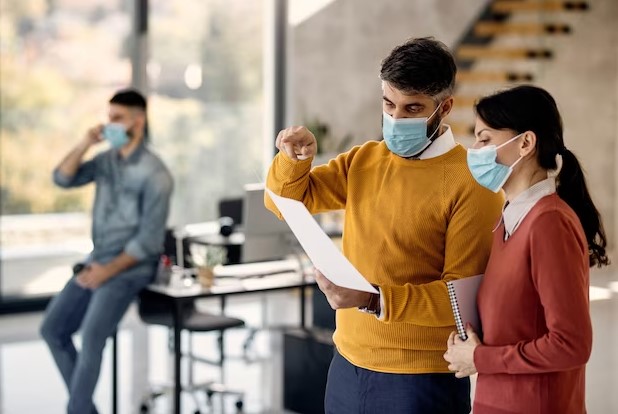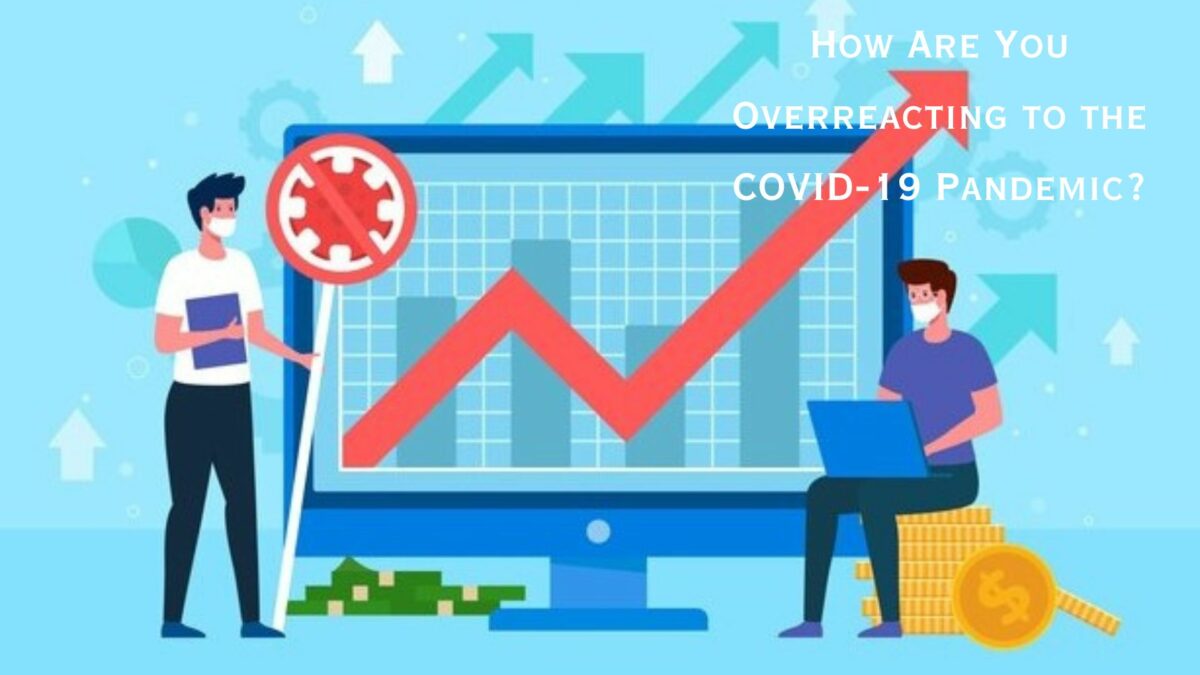Nervous people tend to overreact.
–Toba Beta
If you’ve been reading my articles on coronavirus and your personal finances, you probably note a general tone to the articles: “overreact” on the side of caution.
To wit, I’ve recommended:
- Saving your COVID-19 government stimulus check and not investing it.
- Seriously considering drawing down your HELOC.
- Rethinking your early retirement plans.
- Making your emergency fund larger.
- Permanently adjusting our personal finance behaviors, and
- Seriously reducing your expenditures.
Negative, negative, negative Nelly!
There’s another side of the equation that I haven’t covered, since, after all, I’m not in the position to give investment advice, your situation may vary, past performance doesn’t guarantee future returns, you should speak with your advisor before acting, and I did not sleep in a Holiday Inn Express last night!
As many of my long-time readers know, I am a big fan of Nassim Taleb. I’m also not nearly as smart as he is, nor am I as successful.
I’ve recently been reading Antifragile: Things That Gain From Disorder (#aff). This is the third book of his Incerto series about extreme events that happen more often than we think that they do.
I rarely go back and reread entire sections of books, but I have done so many times with this book.
One quotation is particularly pertinent to how I’ve been thinking about how to react during the coronavirus pandemic:
If you sat with a pencil and jotted down all the decisions you’ve taken in the past week…you would realize that almost all of them have had assumetric payoff, with one side carrying a larger consequence than the other. You decide principally based on fragility, not probability
(note: italics are the author’s)
What does that mean?
It means that, if the consequence of a decision is fatal to you, then you don’t make that decision unless the odds are very remote. Take airplanes. If there was a 1:100 chance of a plane crashing, you’d never fly. Instead, the chances are about 1 in 5.4 million.
Most of us are familiar with the bell curve. I talked about it in “How to Use Six Sigma Techniques for Your Budget.”
In a nutshell, it means that most outcomes in whatever field you’re predicting or evaluating outcomes for tend to hover around an average.
It’s an easy heuristic for us to believe in.
It’s also usually incorrect.
Take hundred year floods. How often have we heard that phrase uttered in our lifetimes? If it was true, we’d hear it once.
So, “extreme” outcomes happen more often than we think. Some are good. Some are not so good.
By and large, the COVID-19 pandemic is a bad extreme.
On April 9, 2020, another 6.6 million Americans filed for unemployment, bringing the total (to now, and probably underreported) to 16.8 million.
As of April 9, 2020, there were 1.57 million reported cases of COVID-19 and over 92,000 deaths reported from it (both are probably underreported).
It’s not World War II horrific, but it’s not a sunny, spring day, either.
But, in reality, if we’re significantly overestimating the mortality rate from the novel coronavirus (and I think we probably are), why am I still making all of these “overreacting” recommendations?
As Taleb suggests, we want to prepare for a barbell-shaped distribution rather than a bell curve-shaped distribution of outcomes in our lives.
Preparing for the Downside

As I alluded to earlier, all of the articles about COVID-19 that I’ve published to date are attempting to prepare for a bad case scenario.
Joseph Stalin once said “When one dies, it is a tragedy. When a million die, it is a statistic.”
You may think that you’re unlikely to be affected by the coronavirus pandemic.
You may think that your job is “recession-proof” and that you can’t be laid off, furloughed, or have your salary cut.
You might be right.
However, if you’re in a position where, if you’re wrong, you’re in deep financial trouble, then you cannot assume that you are going to be safe.
It’s not the probability that kills you. It’s the magnitude of the outcome in the small probability scenario.
We know people who have had their hours reduced and their pay cut as their businesses try to survive. One of my portfolio companies had to furlough workers to deal with a slowdown in demand.
Just like I recommend having around $600,000 of excess capital to self-insure instead of buying long-term care insurance, we buy insurance for the things that we cannot self-insure.
I’m not aware of a commonly sold or reasonably priced job insurance product that you can buy, aside from disability insurance, which doesn’t protect you from being laid off because of economic reasons.
So, what is your insurance against job loss?
An emergency fund.
Lowering your expenses.
Working on developing a side gig.
If you had a couple of years’ worth of expenses in CDs or a money market fund, you probably wouldn’t be too worried about what are, in all likelihood, going to be the relatively short-term economic impacts of COVID-19. You may alter your behavior a little, but you probably are more worried about social distancing than putting food on the table next month.
In Taleb’s terminology, you’re antifragile to the personal finance impacts of COVID-19.
And what if you keep your job, don’t get sick, and are never impacted by COVID-19 despite taking these precautions?
Are you harmed irrevocably?
No.
Your actions acted as insurance against the unthinkable.
Sure, you can’t prove a counterfactual (“you’d have been really glad you had that money set aside if you did lose your job!”), but you don’t want to prove that counterfactual any more than you want to have to make a claim on your homeowner’s fire insurance policy.
But, I’d also argue that of the 16.8 million people in the U.S. who are currently unemployed, 16.7X million of them didn’t see it coming on January 1.
The point is that very few people see the extreme events coming until they’re in the middle of the event, and it’s too late to do anything about it.
We may not think the bad things will happen to us, but it’s smart to prepare as if they are.
Saving 15 months in an emergency fund instead of 6 may delay your retirement by a year. But, if you wind up unemployed, you’re in a lot better shape. The tradeoff is worth it, because, otherwise, you’re exposed to a highly negative asymmetric outcome.
But, there’s also the other side of the barbell equation, and the thing that I haven’t talked about in regards to the COVID-19 pandemic until now…
Preparing for the Upside of Extreme Events

As we saw in my previous evaluation of Taleb’s works, he made his money by investing in deep out of the money options.
His thesis is that the tail end options are mispriced. They are priced as if the world is a bell curve, and it’s actually a barbell.
So, when extreme events happen, he’s able to take advantage of the mispricing and get outsized returns compared to the implied probability priced in those options.
It took me a month into the COVID-19 pandemic, reading Antifragile, and a long dog walk with my wife to realize the implications.
Now is one of those barbell events.
Even though I recommend investing 5% of your capital in higher risk investments, “moonshots,” we’ve never really made those types of investments.
After all, I was an entrepreneur for 15 years before retirement, so our at risk capital was in the jobs I created with those companies and the stock that we owned in each. We only put in a tiny amount of seed capital ourselves, so our leverage on that investment was extraordinarily high.
Now that we’re retired, though, we plan as if all of our remaining private holdings are valued at $0 (sorry, Dave and Ben). Any returns from those holdings are pure upside as far as we are concerned, and they don’t affect our retirement plans one iota.
But, we do have excess capital. We’d been planning on continuing to opportunistically buy real estate, since that was how we are able to consistently generate outsized returns.
Those aren’t moonshots, though. I am pretty confident that we can formulaically get between 15-20% ROI on our real estate investments.
What is a moonshot is trying to take advantage of the stock market falling off of a cliff because of COVID-19.
However, just buying stocks or ETFs doesn’t create a moonshot. Let’s say that the market returns to pre-COVID-19 levels by the end of the year and we bought at the bottom. We’d have a 30% return on our money for the year and then regular returns.
That’s a lot of risk for a return that’s not much higher than we can get just by buying real estate.
What we did, instead, was buy deep out of the money long term equity anticipation (LEAP) options to try to take advantage of deep swings from here.
I’m not going to go any deeper into this because a) I’m not your investment advisor, and b) your situation is specific to you.
In a broad stroke, this was money that we could afford to lose completely. If our bets are wrong (and, while I think they’re educated, they’re most certainly bets), and all of our purchases go to $0, we’re not materially harmed by the decision. In all likelihood, come the time that we’d need to tap into those funds, we’d never notice the difference. It’s truly at-risk money that doesn’t impact us now or in the future.
However, if we’re right and the leverage of the options plays out, then these are moonshot investments.
They would materially impact our standard of living in retirement.
As Taleb explained, the other end of being antifragile is being able to disproportionately take advantage of upside risk as well.
His investment strategy is to keep most of his money in very safe, boring investments and to take a lot of small bets in investments that have disproportionate upside opportunities.
We have done the same for now.
After all, COVID-19 might not be a once in a lifetime stock market event, but it’s rare enough for us to try to shoot for the moon, while we remain liquid enough to last quite a while before having to take actions that would help us not run out of money in retirement.
How have you tried to deal with the upside and the downside risks presented by the coronavirus pandemic? Let’s talk about it in the comments below.
Author Profile
- John Davis is a nationally recognized expert on credit reporting, credit scoring, and identity theft. He has written four books about his expertise in the field and has been featured extensively in numerous media outlets such as The Wall Street Journal, The Washington Post, CNN, CBS News, CNBC, Fox Business, and many more. With over 20 years of experience helping consumers understand their credit and identity protection rights, John is passionate about empowering people to take control of their finances. He works with financial institutions to develop consumer-friendly policies that promote financial literacy and responsible borrowing habits.
Latest entries
 Low Income GrantsSeptember 25, 2023How to Get a Free Government Phone: A Step-by-Step Guide
Low Income GrantsSeptember 25, 2023How to Get a Free Government Phone: A Step-by-Step Guide Low Income GrantsSeptember 25, 2023Dental Charities That Help With Dental Costs
Low Income GrantsSeptember 25, 2023Dental Charities That Help With Dental Costs Low Income GrantsSeptember 25, 2023Low-Cost Hearing Aids for Seniors: A Comprehensive Guide
Low Income GrantsSeptember 25, 2023Low-Cost Hearing Aids for Seniors: A Comprehensive Guide Low Income GrantsSeptember 25, 2023Second Chance Apartments that Accept Evictions: A Comprehensive Guide
Low Income GrantsSeptember 25, 2023Second Chance Apartments that Accept Evictions: A Comprehensive Guide

